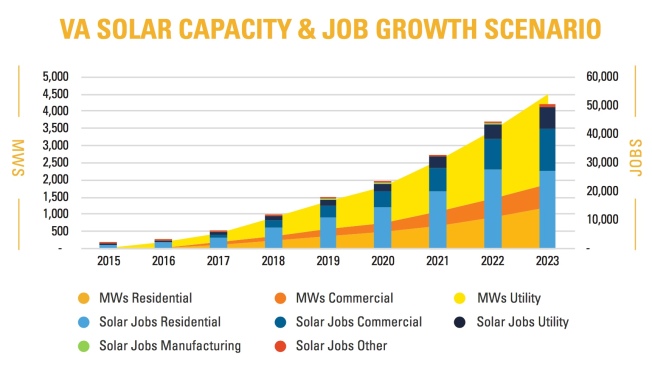The Solar Foundation has released its National Solar Jobs Census for 2018, showing solar jobs in Virginia increased from 3,565 in 2017 to 3,890 in 2017, an increase of 9%.
That puts Virginia 20thin the nation for solar jobs, though only 34thif measured on a per capita basis.
Nationwide, solar job numbers fell 3.2% to 242,000 jobs as the Trump administration’s tariffs on solar panels took a toll, yet 29 states saw increases. The Solar Foundation projects a 7% increase in 2019.
The Virginia job numbers sound good until you compare us to the competition. To the south of us, North Carolina continues to eat our lunch, with 6,719 solar jobs, while Maryland to the north has 4,515. Both these states lost jobs compared to 2017, but remain way ahead of Virginia both in absolute terms and jobs per capita. (Not surprisingly, they also have a lot more solar installed.)
In fact, measured in solar jobs per capita, Virginia remains an East Coast laggard. Every state on the Atlantic except Georgia and Pennsylvania has more solar workers per capita than Virginia has—and those two states are not far behind us.
This is especially unsettling because while North Carolina and states to the north of us have renewable portfolio standards (RPS) that require their utilities to buy renewable energy, most southeastern states do not. The fact that they are beating Virginia on solar jobs suggests we have a lot of room left for improvement.
In spite of shrinking employment and the impact of tariffs, solar installations nationally rose 8% in 2018, according to Bloomberg New Energy Finance (BNEF) in its Sustainable Energy in America Factbook. (BNEF also shows higher job numbers for solar than the Solar Foundation recorded, possibly due to different methodologies.)
More installed capacity by fewer workers may reflect higher productivity on the part of the industry, as installers learn to work better and faster, and as communities support them with streamlined permitting and public education.
The growth in utility-scale solar is surely a factor also. Rooftop residential and commercial solar is labor-intensive, while large, ground-mounted arrays allow significant economies of scale. Statistics from the Solar Energy Industries Association (SEIA) show utility-scale solar has been driving much of the increase in solar installations over the past several years.
Although solar remains a very small part of the nation’s overall energy mix, the BNEF report shows it makes up a significant share of new energy being built, even beating out natural gas in 2016 and 2017. BNEF also shows solar jobs run only barely behind jobs in gas. Considering only electric generation, solar jobs are way ahead of all other sources, including gas. (Coal lost the jobs race several years ago, even in Virginia, and in spite of the subsidies we throw at coal mining.)
For Virginia policy makers who are focused on job creation, solar is a clear winner. As the Solar Foundation notes, “In the five-year period between 2013 and 2018, solar employment increased 70% overall, adding 100,000 jobs. By comparison, overall U.S. employment grew only 9.13% during that same period.”
This article originally appeared in the Virginia Mercury on February 14, 2019.





